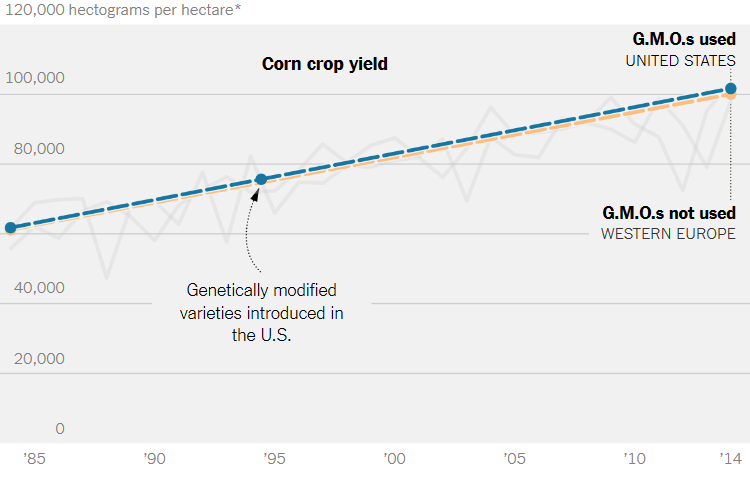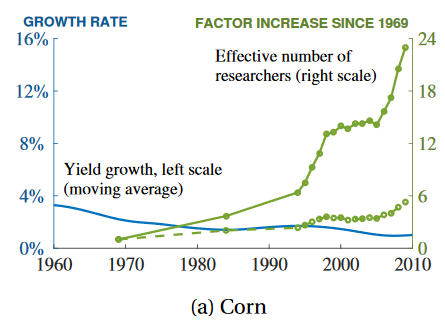Happy Thanksgiving! Let& #39;s talk corn. In 2016, the NYTimes presenting the following figure to argue that the introduction of genetically engineered (GE) corn did not increase crop yields! Can this be true? Let& #39;s look at some research. #ThursdayThreads
https://www.nytimes.com/interactive/2016/10/30/business/gmo-crops-pesticides.html">https://www.nytimes.com/interacti...
https://www.nytimes.com/interactive/2016/10/30/business/gmo-crops-pesticides.html">https://www.nytimes.com/interacti...
(Disclaimer: this thread isn& #39;t going to touch the controversy about the impact of GE crops on health or the environment. It& #39;s an important issue but I don& #39;t have anything interesting to say about it.)
The NYT also quoted (p. 154) a 2016 report by the National Academies of Science that found "little evidence" of an increase in yield growth due to the introduction of GE seeds. http://nas-sites.org/ge-crops/2016/05/17/report/">https://nas-sites.org/ge-crops/...
It would be pretty surprising that the nearly universal adoption of GE corn in the USA had no positive effects for farmers. No one is forcing them to buy the stuff; are farmers collectively making a big error?
The trouble is that yield is influenced by more than just the genetic stock of the plant. Contra these reports, @ArielOrtizBobea and @TackJesse (2018) find that corn yields rose by 0.94% per year before 1996, and by 1.59% per year after. https://iopscience.iop.org/article/10.1088/1748-9326/aae9b8">https://iopscience.iop.org/article/1...
OT show these results depend on weather. Weather conditions in the corn belt were apparently more favorable before 1996 than after. When they do not control for changing weather conditions, they also find there is no change in yield growth when GE crops became available.
This figure from the Iowa fifth crop district (where I& #39;m writing from) nicely illustrates the importance of controlling for weather. The blue & green lines are yield trends when you do not account for weather, the red one is yield trends when you do.
As OT note, these results don& #39;t necessarily mean the advent of GE crops drove the increase in yields. But they document a change in yield growth around the time GE crops became available, so long as you control for weather.
@JaysonLusk, @TackJesse and @NathanHendricks (2017) explore the same issue, adding data on the adoption rate of GE seeds by state, and data on soil characteristics. https://www.nber.org/papers/w23519.pdf">https://www.nber.org/papers/w2...
They also find adoption of GE crops is associated with higher yields, but this effect is hidden if you do not account for changing weather in the corn belt.
But in some sense, all of this misses the point. GE seed research is not only (or even primarily) about increasing yields; it& #39;s largely about conferring insect and herbicide resistance, which allows farmers to save time or money on their use of inputs.
Ciliberto, Moschini and @EdPerry (2019) take a completely different approach. Rather than looking at measures of yield, they look at farmer choices. CMP assume farmers are rational, and buy the seeds that maximize profit. https://onlinelibrary.wiley.com/doi/10.1111/1756-2171.12290">https://onlinelibrary.wiley.com/doi/10.11...
Using data on the price of different seeds available over 1996, as well as the actual purchase decisions of farmers, they back out the maximum willingness-to-pay (WTP) of farmers for different GE traits.
It turns out farmers perceive GE traits as valuable relative to conventional seed options; they buy these seeds, despite a price premium over alternative options.
And GE traits appear to become more and more valuable over time - in one specification, the estimated WTP for an herbicide resistance trait rises from $1.38/acre in 1996-2000, $3.57/acre in 2001-2006, and $17.01/acre in 2007-2011.
To close; this chart from Bloom, Jones, @johnvanreenen and Webb has been getting lots of play: we& #39;re throwing more and more scientists at corn but increases in yields are not rising in step. Maybe innovation is getting harder? https://web.stanford.edu/~chadj/IdeaPF.pdf">https://web.stanford.edu/~chadj/Id...
We& #39;ve seen that there are a few caveats that should be added to this figure. First, naive trends in yield growth will understate actual yield growth in the GE period because weather has differed over the period under observation.
Second, much of the value from GE technology may not be due to higher yields, but via increased profitability from changing input uses. By one estimate, farmer WTP for some GE traits rose 12-fold over the GE era!
Are these caveats enough to overturn the conclusion that we& #39;re getting less bang for our R&D buck? That& #39;s beyond the powers of this twitter thread to say. But at least the move to GE corn delivered on something.
Whoops, tagged the wrong @EdPerry285
...and tagged the wrong @nphendricks

 Read on Twitter
Read on Twitter






